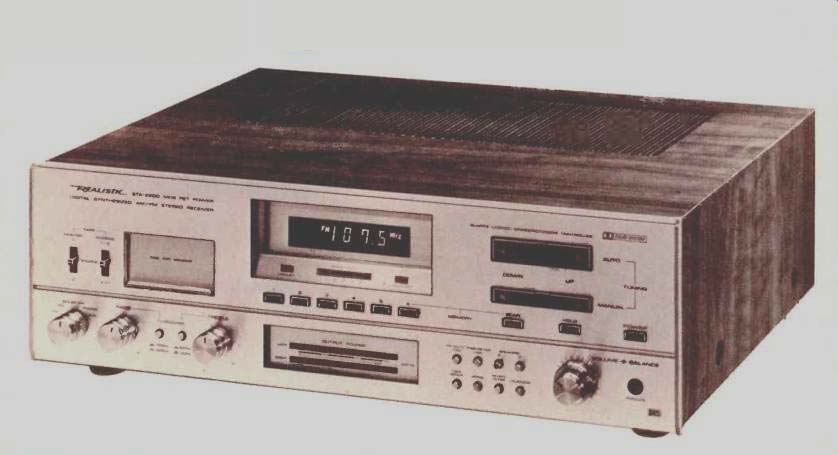
Manufacturer's Specifications:
FM Tuner Section:
Mono Usable Sensitivity: 10.3 dBf (1.8 uV/300 ohms).
Mono S/N: 68 dB.
Image Rejection: 75 dB.
Capture Ratio: 1.5 dB.
I.f. Rejection: 95 dB.
AM Suppression: 55 dB.
Harmonic Distortion: Mono, 0.2 percent; stereo, 0.3 percent.
Stereo FM Separation: 48 dB at 1 kHz.
AM Tuner Section
Sensitivity: 10 uV.
Image Rejection: 45 dB.
I.f. Rejection: 47 dB.
Distortion: 1.0 percent.
AM Frequency Response: 40 Hz kHz, ±6 dB.
Amplifier Section
Rated Power Output: 60 watts/ channel, 8-ohm loads, 20 Hz to 20 kHz.
Rated THD: 0.02 percent.
Input Sensitivity: Phono, 2.2 mV; high level, 160 mV.
Phono Overload: 200 mV.
S/N: Phono, 65 dB; high level, 75 dB.
Bass Control Range: ±10 dB at 50 or 100 Hz.
Treble Control Range: ±10 dB at 10 or 20 kHz.
Price: $599.95.
Audio components bearing the name "Realistic" are manufactured exclusively for and sold by the thousands of Radio Shack stores located throughout the United States and through their widely circulated mail-order catalogs. The company headquarters in Texas is manned by its own engineering staff who supervise the products which are then generally manufactured overseas. It is indicative of the general trend in stereo receivers to note that last year, Radio Shack's top mod el, selling then for just under $600.00, offered 120 watts of power per channel, exactly twice as much as this year's entry at that price point, the STA-2200. Clearly, the emphasis here is on sophisticated features, such as true frequency synthesis, which is incorporated in the STA-2200, rather than on the so called "power race." The digital display system used in con junction with the frequency synthesis tuning system, the 12-station memory system (6 for AM and 6 for FM stations), the use of the digital display as a time clock plus its alpha designations of program source, stereo FM reception, etc. all add to the cost of this receiver so that, in effect, Radio Shack has traded power for convenience features and tuning accuracy--worthwhile trade-offs in my view.
The gold-colored front panel of the STA-2200 features a large, highly visible digital display used to indicate both AM and FM frequencies selected. FM frequencies are displayed in 200-kHz increments, while AM stations are tuned in 10-kHz increments. When programs other than AM or FM are selected, the display becomes a digital time clock, indicating "AM" or "PM." Even in the radio listening mode, the user can cause the display to revert to time indications by depressing a push button located behind a small "sliding door" panel to the left of the display area. Additional buttons set the hour and minute of the digital clock, dim the intensity of the display, turn off output-power LED displays and signal-strength LEDs, and activate the "station memory" feature.
When the "memory set" button is depressed, the listener has five seconds in which to enter the frequency of a station (either AM or FM) by depressing one of the six numbered buttons located beneath the digital readout area. To the left of the sliding panel door are tape monitor and dubbing switches used in conjunction with up to two tape decks connected to the receiver.
Several tuning options are available. Pressing the tuning "Up" or "Down" buttons starts the electronic tuning system scanning in the chosen direction until the next usable signal is received. Other buttons, equipped with arrows like the first pair, are used for manual tuning while just below these is a "scan" button which, if depressed, starts the tuner scanning to each of the memorized station frequencies in turn, pausing for five seconds at each frequency for quick auditioning. A hold button stops the scanning sequence if the listener chooses to remain tuned to one of the pre-selected stations. The usual power on/off switch is located at the lower right corner of the panel.
Two rows of 10 LEDs each, located at the lower center of the panel, serve as power-output indicators and are calibrated in watts, referred to 8-ohm loads. A push button nearby selects 10 watts or 100 watts as full-scale for these indicators. Other push buttons in this area of the panel include an FM mute switch, mono/stereo switch, an MPX high-blend filter switch, and a loudness-contour switch. Concentrically mounted volume and balance controls are located at the lower right of the panel, along with the usual stereo phone jack. Bass and treble controls at the left section of the panel have a pair of tiny push buttons located between them. These select either of two bass or treble turnover frequencies at which boost or cut is to begin (150 Hz or 300 Hz for the bass control, 6 kHz or 3 kHz for the treble control). The program selector rotary switch is also located in this section of the panel, and in addition to the usual phono, AM, FM and AUX settings, there is a setting for Dolby FM. The complete required Dolby FM circuitry is included in the receiver together with the necessary 25-microsecond de-emphasis characteristic required when listening to such transmissions.
The rear panel of the STA-2200 contains a line fuseholder and switched and unswitched a.c. receptacles at the left, while nearby there are spring-loaded, color-coded speaker terminals for up to two pairs of speakers systems. Surprisingly, there are also phono-tip jacks for speaker connection, just in case the user owns a pair of speakers having permanent cables terminated in such plugs. Two sets of tape-out/tape in monitor circuit jacks are provided, as are European type DIN multiple-contact connectors. Preamp-out and main-amp input jacks are interconnected by wire jumpers which may be removed for separate access to these two sections of the receiver. High-level (AUX) and low-level phono inputs are located far from any a.c. hum fields at the opposite end of the rear panel, as is a chassis-ground terminal. The 75-ohm and 300-ohm FM and external AM antenna terminals are located at the upper right of the panel; the usual pivotable AM ferrite bar antenna is also provided.
The internal view of the receiver discloses the excellent layout which has been used in constructing this versatile receiver. The FM front-end is equipped with a dual-gate MOS FET r.f. amplifier, and tuning is accomplished by means of varactor diodes, controlled by a microprocessor. The FM i.f. section employs three ICs and three linear-phase ceramic filters. A quadrature detector is used to recover the FM composite audio signal which is fed to a phase-locked loop stereo-MPX-decoder circuit C-MOS IC. MOS-FETs are also used in the power amplifier section. Automatic protection circuits protect the output devices against voltage surges, overloads, speaker shorts and thermal overheating, which may also affect the speakers.
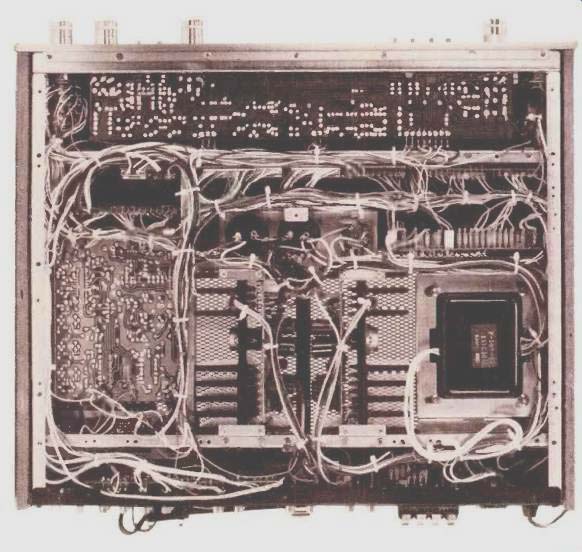
FM Performance Measurements
The curves of Fig. 1 indicate general quieting and distortion characteristics of the tuner section of the STA-2200 for both mono and stereo FM operation. Usable sensitivity in mono measured 9.8 dBf (1.7 uV), actually a bit better than claimed. Stereo sensitivity was an impressive 17.2 dBf, or 4 uV referred to 300-ohm inputs.
As in the past, Radio Shack proves reluctant to publish a great many performance measurement specifications for their high-fidelity products. Their reasoning is that such technical specifications tend to confuse prospective purchasers who would rather hear how the product sounds than worry about the "numbers." While that may well be so, we still believe that our readers want to know as much about the product as possible, and that means both objective measurements and subjective listening tests. Accordingly, we measured just about all of the FM performance parameters possible. Specifically, 50-dB quieting in mono was an excellent 2.5 uV or 13 dBf. In stereo, the 50-dB quieting point was reached with input signals strengths of 36.5 dBf or 36.8 NV. Radio Shack does report an S/N ratio in mono of 68 dB and that is exactly what we measured. In stereo, the S/N drops slightly, to 65.5 dB. With Dolby FM circuitry turned on (and test signals adjusted appropriately at the signal generator), the signal-to-noise ratio improved to 70.5 dB in mono and 69.5 dB in stereo.
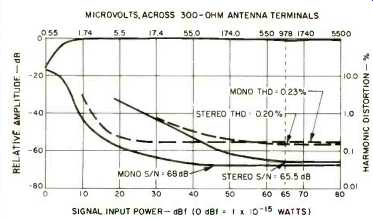
Fig. 1--Mono and stereo quieting and distortion characteristics.
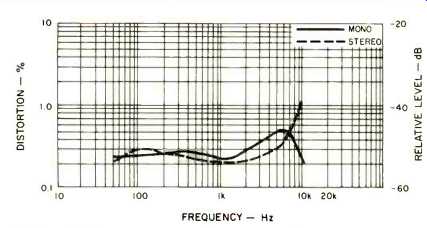
Fig. 2--THD vs. frequency, FM tuner section.

Fig. 3--Frequency response and stereo separation.
Fig. 4--Crosstalk components for 5-kHz signal.
Fig. 5--Action of Dolby FM decode section at different modulation levels.
Fig. 6--AM frequency response.

Fig. 7--Distortion vs. power output. Fig. 8.- Distortion vs. frequency at
rated output.
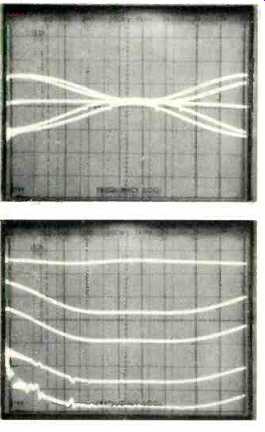
Fig. 9- Bass and treble control range.
Fig. 10- Loudness control compensation at various control settings.
Unlike conventional signal-strength meters, which are generally useless above signal strengths of 50 p V or so, the LEDs used in the STA-2200 to indicate signal strength were sensibly calibrated, as follows: 70 pV, 100 y V, 230 p V, 500 p V, 1600 p V, in ascending order from illumination of the first through the fifth LED. At reference signal levels of 65 dBf, distortion in mono measured 0.23 percent at 1 kHz, while in stereo the harmonic distortion level was actually a bit lower, 0.20 per cent. These distortion readings remained fairly constant at mid and low frequencies, as shown in Fig. 2, but increased to 0.52 percent at 6 kHz for mono and to 0.36 percent in stereo for the same test frequency.
Frequency response was extremely flat from 30 Hz to 15 kHz, with no more than 0.5 dB deviation at any frequency in between those extremes. Response, as well as separation characteristics in stereo FM, are depicted in Fig. 3. Separation at 1 kHz (lower curve) was 50 dB, decreasing to 40 dB at 10 kHz and 44 dB at 100 Hz. The center trace in Fig. 3 shows the decrease in separation that occurs when the MPX high-blend switch is activated. Sweeps in this and other 'scope photos run from 20 Hz to 20 kHz, and vertical sensitivity is 10 dB per division unless otherwise noted.
Figure 4 depicts a linear sweep of our spectrum analyzer from 0 Hz to 50 kHz. A 5-kHz reference signal occupies full screen height (desired channel signal), while a second sweep of the output of the opposite channel shows separation at 5 kHz (approximately 42 dB) as well as other crosstalk and sub carrier (19 kHz and 38 kHz) components to the right of the desired signal frequency.
Tracking of the Dolby FM circuitry seemed to be a bit off, as can be seen by examining the upper curves of Fig. 5. Note that now response is no longer flat over the entire audio range but seems to roll off a bit at the high end, even at full modulation levels. At lower modulation levels (lower curves), we see the action of Dolby decoding as the response curves are altered compared with those above.
Capture ratio of the FM tuner section measured 1.5 dB as claimed. Alternate channel selectivity was better than 70 dB, and AM suppression measured marginally better than claimed with readings of 56 dB. Image rejection was 75 dB, while spurious rejection was 83 dB. Stereo threshold occurred with signal inputs of 20 dBf, and muting threshold was set at 4 uV (17.2 dBf).
Much to Radio Shack's credit, they are one of the few makers of stereo receivers or tuners who specify frequency response for the AM tuner section of their products. As shown in the spectrum sweep of Fig. 6, they actually do a bit better than claimed, with response extending from 40 Hz to 3.5 kHz for a ±6 dB tolerance. Clearly, nothing to rave about here, but at least the spec is legitimately stated.
Amp and Preamp Measurements
At mid-frequencies, the power amplifier section of the STA-2200 receiver delivered a full 70 watts per channel into 8-ohm loads for its rated THD figure of 0.02 percent. For the same level of SMPTE-IM we were able to push outputs to the equivalent of 85 watts, as shown in the curves of Fig. 7. As might be expected, power output at the frequency extremes of 20 Hz and 20 kHz was not as great, but nevertheless exceeded the published rating of 60 watts. We measured out puts of 67 watts per channel at 20 Hz and at 20 kHz for 0.02 percent THD. Power bandwidth (for the rated 60 watts per channel output) extended from 9 Hz to 31 kHz, and the amplifier had a damping factor (referred to 8 ohms and measured with a 50-Hz signal) of 68. Dynamic headroom was a comfortable 1.58 dB, and we measured a slew rate of around 13 volts per microsecond.
Frequency response, measured via the high level (AUX) inputs, extended from 8.5 Hz to 27 kHz for -1 dB roll-off and from 4.0 Hz to 55 kHz for the-3 dB roll-off points. Phono input sensitivity, measured in accordance with IHF/EIA standards, was 0.28 mV (for 1-watt output), while signal-to noise in phono for a 5-mV input signal and referred to 1-watt output measured 72 dB. For the high-level inputs, input sensitivity was 18 mV, and S/N (this time referred to 1-watt out put with a 0.5-volt input) measured 77 dB. At minimum volume settings, the S/N improved (again, with respect to 1-watt output) to 83 dB. Phono overload at 1 kHz measured 200 mV.
Always a welcome feature in an all-in-one receiver, the action of the selectable turnover-type tone controls is depicted in the multiple sweeps of Fig. 9. Note that when the 150-Hz bass turnover and 6-kHz treble turnovers are selected, midrange frequencies are virtually unaffected when the controls are in their full clockwise (boost) or counterclockwise (cut) positions. Loudness contour curves shown in Fig. 10 are typical of those obtained with this type of volume/loudness circuitry.
Listening Tests and Summary
As some of our test results indicate, frequency synthesis in tuners, while it certainly insures near-perfect tuning accuracy, does not generally result in a tuner that exhibits state-of the-art signal-to-noise or distortion figures. The choice of this sophisticated tuning system along with its station memory facility in no way affects amplifier or preamplifier performance, both of which were exemplary in the sample I tested.
When operated within its rated power levels, the Realistic STA-2200 delivered clean, natural sound in phono and tape reproduction. Tone controls are well designed, and the sub sonic filter in the phono section is a welcome addition, even if it has to be built-in and permanently "on." The pure audiophile may not think highly of the fancy tuning schemes, the LED displays, the digital time clock and the alpha-numeric displays generally, but we would guess that the music enthusiast who simply seeks convenience, ease of use, and reliable FM and AM performance will find the STA-2200 to be appealing both in price and in performance. With speaker efficiency higher than it was a few years ago, the 60-plus watt per channel capability of this receiver should fill the needs of most listeners who want an integrated receiver. The tradeoff chosen by Radio Shack was a wise one!
-Leonard Feldman
(Adaped from Audio magazine, Feb. 1981)
Also see:
Realistic (Radio Shack) Model STA-225 AM/FM Stereo Receiver (Equip. Profile, Dec. 1975)
Realistic (Radio Shack) STA-120B AM /Stereo FM Receiver (Dec. 1972)
Realistic Model SCT-30 Cassette Deck (Jun. 1979)
= = = =